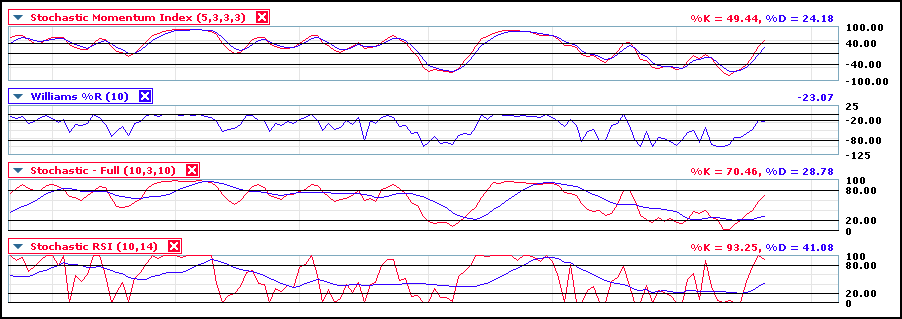Advanced Stochastic Indicators
Advanced Stochastic Analysis, Can You Improve On A Good Thing?
Anyone who knows me knows that I am quite fond of the Stochastic Oscillator. It is a tool created by George C. Lane and seeks to make sense of the seemingly random movement of the market. In fact, the very name is a derivative of the Greek word stochos which means unknowable and random. The idea is that while the day to day, or shorter term, movements are random but over time that randomness will reveal an underlying pattern. It is good for analyzing trend direction and strength, providing clear entry signals and for foreshadowing weakness and reversal. The indicator is in of itself very useful but there have been some enhancements made over the years. This is a guide into some of the other tools based on stochastic and how you can use them in your trading.
The Williams% Ratio – Williams% Ratio is a spin on the fast stochastic indicator. While stochastic compares current closes to the low of the period Williams% compares to the high. This results in a negative number and an oscillator that ranges between 0 and -100, opposite to the fast stochastic. When compared to fast stochastic the lines are nearly identical. The major difference, aside from the scaling, is that Williams% Ratio does not include a signal line. This is a drawback as it does not provide signals on short term swings. However, it is still very useful for identifying support/resistance, trend analysis and to predict reversal.
The Stochastic Momentum Index – The stochastic momentum index, SMI, is an oscillator that compares closing price to the mid-point of the set range whereas standard stochastic is comparing to the low of the period. This creates a reading that is either positive or negative, and an oscillator that ranges above and below 0, rather than between 0 and 100. Another difference is that the readings are double smoothed which makes for a lot less whipsaws in %K. Regardless of the differences the indicator is read in exactly the same way as the standard model. However, instead of looking for overbought 80 and oversold below 20 you will be comparing peaks relative to past performance. There is a major drawback to this indicator as well. Because of the method in which it is derived, and due to the double smoothing, it is not effective at trend analysis and is more suited to determine shorter term overbought/oversold conditions.
Stochastic RSI – Stochastic RSI is actually a combination of two great indicators, stochastic and RSI. This indicator is a standard version of stochastic, but rather than using closing price in the formula, it uses the RSI reading. This gives a stochastic look at the relative strength of the underlying asset. At a glance you can see that this produces an indicator that is both faster and slower than the standard stochastic. The %K fluctuates wildly but creates a %D that is much smoother and slower moving, making it give off a lot of signals. This also means it can give off a lot of false signals so additional analysis will of course be required.

My Conclusions; Can You Improve On Stochastic
I have to say that no, you really can’t improve on the stochastic oscillator. It is easy to read, is based on sound theory, provides clear signals and is highly versatile. The others all try to make some improvement but all fall short for one main reason; they all introduce a fault into the indicator. Williams% Ratio does not include a signal line so is not useful for short term trading and swing signals. The stochastic momentum index is so smoothed that it smooths out half the signals the stochastic is intended to give. The stochastic RSI is so wild it creates a lot of whipsaws. By no means are these tools useless, they just aren’t as good as the tool they are based on. You just can’t beat stochastic. My advice to you is not to spend your time looking for a holy grail, or trying to improve on tried and true techniques. You will have much better success by focusing your attention on proven techniques and learning to use them appropriately.